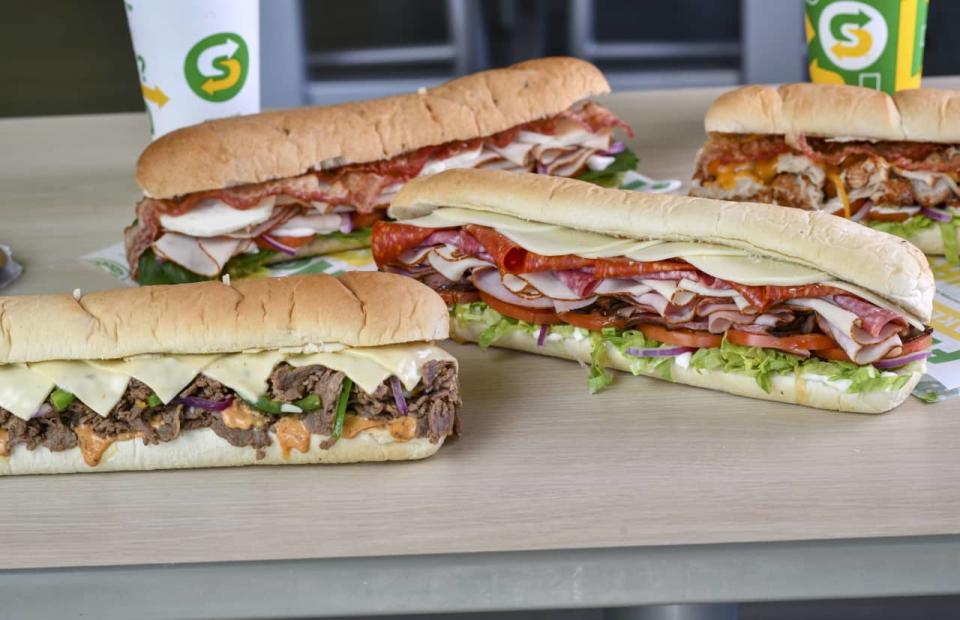
It’s been years since Subway offered a $5 footlong sandwich, a deal celebrated with an ear-catching jingle. Now, the sandwiches can cost up to $15.
And the chain’s regular customers are none too happy about the inflationary state of affairs.
Most Read from MarketWatch
“People too broke for $15 subs,” one Reddit user said.
“I made my own sandwich last night. I calculated it cost me ~$3-$4 worth of ingredients.” another Reddit user noted.
The discussion about Subway’s pricing has been a hot topic of late, especially since news broke that the chain was reportedly having a large-scale meeting with North American franchisees about ways to boost business.
Naturally, customers want to see a return to the good ol’ days of those $5 footlongs and say that’s the best path forward to win their business. “It’s that easy,” another Reddit user said.
The $5 deal ended in 2014, and Subway’s footlongs currently range from around $8 to $15, though prices vary by location. A sandwich combo meal with chips and a drink adds a few dollars to the tab. Extras like more meat and cheese also increase the price.
Admittedly, few fast-food industry watchers predict the $5 deal will ever return. But Subway franchisees told MarketWatch that bargain offerings are still important sales boosters.
“Promotions can only help us increase traffic,” said Monica Laldin, a Subway franchisee in Georgia with seven locations.
Subway does have offers that bring down the cost of a sandwich below the $10 mark, such as a current buy-one-footlong-get-one-free deal. But the chain — which generates around $10 billion in annual sales, and was purchased last year by Roark Capital in a reported $9.6 billion transaction — faces pushback from some franchisees because the offers can cut into profits.
Subway is far from the only fast-food chain dealing with a difficult financial environment, driven in recent years by higher food and labor costs. As chains have increased prices to counter these developments, inflation-weary customers have voiced their displeasure and have often opted not to frequent establishments as much.
McDonald’s MCD has become something of a focal point in this regard, especially when word spread of one location charging nearly $18 for a Big Mac meal. In a recent letter to customers, McDonald’s U.S. President Joe Erlinger indicated that was more the exception than the rule, though he did note that the price for a Big Mac has risen 21% since 2019.
“Inflationary pressures have affected all sectors of the economy, including ours,” Erlinger said.
To woo customers back, fast-food chains have begun offering a wave of deals and discounts, as exemplified by the McDonald’s $5 value meal — which includes a McDouble cheeseburger or McChicken sandwich, a four-piece order of Chicken McNuggets, a small order of french fries and a small soft drink. All items on the McDonald’s $5 meal deal used to be on its dollar menu, which no longer exists.
A Subway spokesperson told MarketWatch that it’s indeed “challenging times for the entire restaurant industry. Our approach to value is thoughtful and strategic, based on data to help balance consumer needs while protecting franchisee profits.”
In some ways, Subway was a victim of its own success with the triumph of the $5 footlong deal and its accompanying jingle, industry experts say. It cemented the idea of the chain as a low-cost leader and arguably left it with less wiggle room to raise prices without facing consumer backlash.
Plus, as Arlene Spiegel, a New York-based hospitality consultant, argues, consumers can find top-of-the-line sandwich options at those higher price levels, so why should they opt for a chain sub that could cost as much as $15?
“Not when you can go to a mom-and-pop Italian deli and get a sandwich with freshly sliced prosciutto,” Spiegel said.
Adding to Subway’s woes: One of its other major marketing campaigns promoted the low-calorie aspect of some of its offerings and spotlighted Jared Fogle, who reportedly lost 245 pounds on a diet of Subway sandwiches. But Fogle later pled guilty in a child sex-abuse case, which damaged the Subway brand, experts say.
“There are still people who won’t go because of the Jared fiasco,” said Mark Kalinowski, a veteran fast-food industry analyst.
Add it all up and Kalinowski said it should come as no surprise that Subway has seen its U.S. store count drop considerably, from 27,129 in 2015 to 20,133 last year. Yet Kalinowski remains relatively bullish about Subway, even with the growing competition it faces from other sandwich chains.
The bottom line: Plenty of people still like their Subway footlongs regardless of how much they cost, he said: “Subway will be around for decades to come.”
Most Read from MarketWatch
EMEA Tribune is not involved in this news article, it is taken from our partners and or from the News Agencies. Copyright and Credit go to the News Agencies, email news@emeatribune.com Follow our WhatsApp verified Channel





